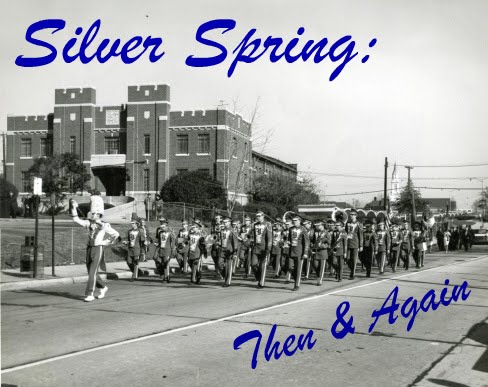Anyone who wants to go out to see a movie in downtown Silver Spring on Christmas Day has an overwhelming selection of film offerings. From sixteen different motion pictures at the Regal Majestic & IMAX to four films at the AFI Silver Theatre.
Fifty-six years ago Silver Spring filmgoers had far less options. Playing at the Silver Theater (note the spelling difference) on December 25, 1955 was the Janet Leigh & Jack Lemmon musical My Sister Eileen. This singing and dancing remake of the earlier 1942 film of the same name was about two Ohio sisters (Leigh and Betty Garrett) seeking success in the big city...and where else in 1955 was that but in NYC's Greenwich Village.
 |
| Maryland News, December 23, 1955, p. 5. Microfilm collection of the Silver Spring Historical Society. |
Both of these Silver Theater/Theatre Christmas Day offerings were second run films with My Sister Eileen (appealing to a mostly female audience) being initially released the previous September and Masterson of Kansas, aimed at the guys, already being a year old having been released the previous Christmas.
The Silver's only other local competition was the Roth's Theatre at 8242 Georgia Avenue, originally opened in 1927 as the SECO (Suburban Electrical COmpany). The SECO was the first movie theater to open in downtown Silver Spring and held the monopoly for eleven years until the Silver opened in 1938.
After the kids opened their Christmas presents that day and settled down for lunch they could shoot over to Roth's to catch the 2:00 pm Walt Disney hit Davy Crockett: King of the Wild Frontier, starring Fess Parker. Even though the movie had ben released the previous May and was nothing more that a compilation of three Davy Crockett television episodes that aired on the ABC television show Disneyland, it was billed as "NOW...ON THE MOTION PICTURE SCREEN!" I'm sure there were plenty of eight year-old boys wearing their coonskin caps in the theatre.
Later that evening the adults could catch Robert Taylor and Kaye Kendall in The Adventures of Quentin Durward, the story of a Scottish night (Taylor) who finds himself in France to facilitate a marriage between a rich and beautiful countess (Kendall) and his aging uncle, King Louis XI, played by Robert Morley. Intrigue ensues. No problem convincing the kids to miss that one.
If you REALLY wanted to see the first release films all one had to do was to catch the streetcar at Alaska and Eastern Avenue and head down to F Street, NW where the Loew's Palace (at 13th Street) and the Capital (at 14th Street) were respectively showing Rains of Ranchipur, a drama about an Englishwoman (Lana Turner!) having an affair with a Hindu doctor (Richard Burton!), and the Vincente Minnelli (Liza'a father) directed musical Kismet, starring Howard Keel and Ann Blyth.
Whatever motion picture you watch this Christmas Day, new release or old, in a movie theater, on television, via dvd or streaming, may it be an enjoyable ending to 2011!









































